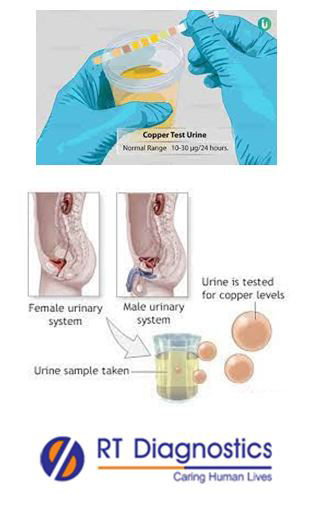Copper 24 Hrs Urine:
Why Copper 24 hour Test?
CLINICAL INFORMATION
Copper is an important trace element that is associated with biological components- complexed with proteins, peptides, numerous metalloproteins (i.e ceruloplasmin, transcuprein, metallothionein), and organic ligands. Some of the biological activities are for the normal functioning of CNS, scavenging of free radicals, melanin synthesis, ferroxidase activities (enzymes that regulate the Iron metabolism), Co-factor for many enzymes, etc. Since ceruloplasmin is an acute phase reactant, the levels of copper in urine is elevated during inflammation. Moreover during the recovery phase, copper in urine levels is well below normal levels thus reflecting the expected physiologic response to replace the copper that was depleted during inflammation. The biliary system is the major pathway of copper excretion, thus eliminated via urine and stool. The copper test is a screening test ordered in copper-associated diseases leading to an imbalance in copper levels in the body leading to some vague signs and symptoms such as jaundice, nausea, tremors, abdominal pain, behavioral changes, fatigue, and difficulty in walking or swallowing, etc. This test screens primarily to diagnose Wilson Disease – hepato-lenticular degeneration (a rare inherited disorder that can lead to excess storage of copper in the liver, brain, and other organs) and also in other biliary obstructive disease conditions like primary biliary cirrhosis, primary sclerosing cholangitis, and also to monitor the treatment (prognosis) in case of estrogen and chelation therapy, etc. The copper 24-hour test helps to determine the amount of copper present in the urine, hence facilitating in screening diseases associated with hypercupriuria - high (hemochromatosis, biliary cirrhosis, thyrotoxicosis, infections, acute and chronic malignant diseases like leukemia) or hypocupriuria - low (malabsorption, nephritic syndrome) copper levels. This test is indicated to determine Wilson’s disease (fatal condition that builds-up excess copper accumulation leading to damage and destruction of liver, kidneys, eye, and brain etc),due to decreased in binding of copper to ceruloplasmin, etc.
Some of the risk factors that can cause copper deficiency are ingestion of high fortified foods with excessive ascorbic acid or vitamin C, iron, zinc (inhibits the absorption of copper), excess use of denture cream containing zinc, foregut surgery, dietary and magnesium deficiency, enteropathies with malabsorption Crohn’s disease, Celiac disease, prolonged intravenous nutrition (total parenteral nutrition, etc), malnutrition, hypoproteinemia, nephritic syndrome, Menkes disease, etc. while hypercupremia is found in primary biliary cirrhosis, primary sclerosing cholangitis, cystic fibrosis, hemochromatosis, malignant diseases (including leukemia), thyrotoxicosis, oral contraceptives, premature babies (high risk of copper deficiency) and various other infections can lead to hypocupremia. Clinical manifestations of copper deficiency include loss of hair, graying of hair, anemia, low body temperature, bone fractures, osteoporosis, low WBC count, irregular heartbeat, loss of pigment from the skin, thyroid-associated disorders, and also a foremost factor contributing to Indian childhood cirrhosis (major cause in malnourished children). While symptoms of copper toxicity include jaundice, vomiting, diarrhea, low blood pressure, blood in urine, and a metallic taste in the mouth. Sample specimens usually are blood, 24 hours urine, liver biopsy, etc. Complications of prolonged copper deficiency can lead to anemia, low WBC count, nerve damage, osteoporosis, muscle weakness, impaired coordination, numbness and tingling in the limbs, irritability and depression, confusion, etc. while high copper levels can lead to complications such as decreased urine output, kidney damage, liver cirrhosis, rupture of RBCs leading to anemia, death, etc. Other associated tests include total copper, free serum copper, copper in 24 hours urine specimen sample estimation, liver biopsy (histo-pathological studies for copper toxicity in tissues), inductively-coupled plasma/Mass Spectrometry.

General Instructions:
Sample Requirement: Specimen - Blood sample collected from the vein. Test Preparation: None.
NOTE - Sample for specimen collections may vary based on the patient’s condition/cases according to the patient’s presenting complaints/signs or symptoms:
SPECIMEN REQUIREMENT (Special or Rare Cases) - As instructed and guided by Physician / Clinician / Pathologist / as per Laboratory’s requirements, according to procedures and protocols.
Sample Requirement: Urine Sample
Test Preparation: None
This Multi-Specialty Clinical Referral Laboratory RT DIAGNOSTICS provides precise and accurate tests with an extensive range of testing services to the medical centers to help in the diagnosis and identification of pathology in the test specimens for infectious diseases and also to evaluate the function of organ systems of the patient. It prevents further complications and helps to stabilize and restore health to near normalcy at the earliest without delay.



